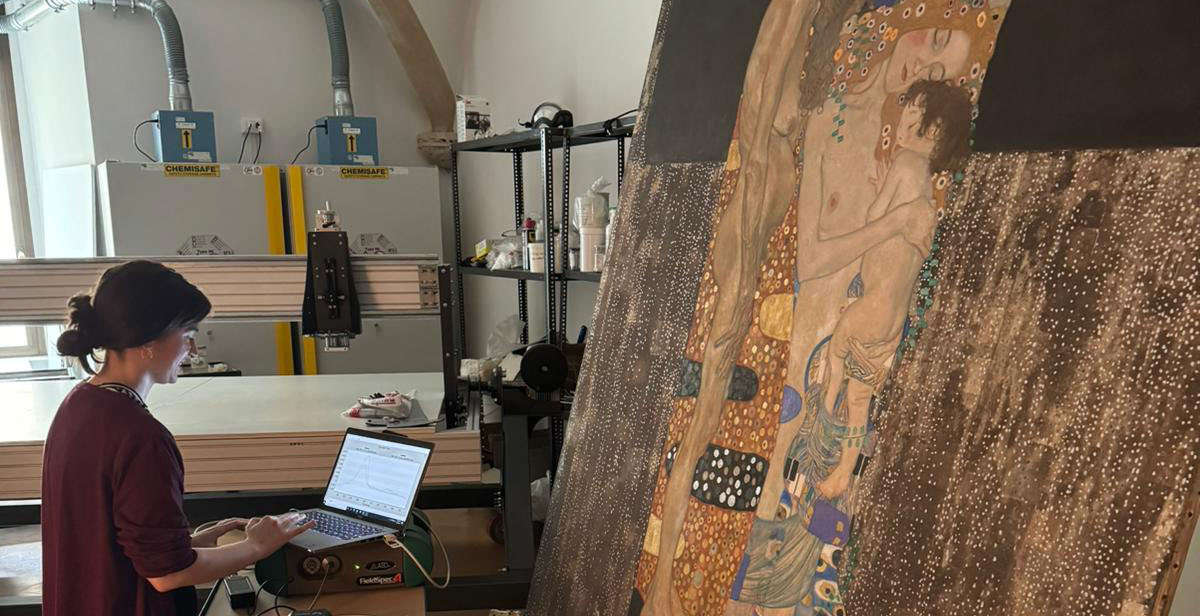A “great discovery” about Gustav Klimt? So in a note sent in recent days by the National Gallery of Umbria to communicate the results of the analysis conducted on The Three Ages, the work by Klimt that belongs to the National Gallery of Modern Art in Rome and was loaned by the Roman museum last summer to mount an exhibition dedicated precisely to the work.
GNAM and GNU, as part of this operation, have also established an agreement to subject The Three Ages to diagnostic investigations in order to clarify some issues that have emerged during the study of the documents and artistic literature concerning the Austrian master’s canvas. Basically, the goal of the analyses, coordinated by the Diagnostic and Restoration Office of the National Gallery of Umbria, was to verify whether Klimt had used precious materials in the execution of the painting. The museums thus requested the collaboration of a team of researchers from the Institutes of Chemical Sciences and Technologies “G.Natta” (CNR-SCITEC) and of Cultural Heritage Sciences (CNR-ISPC) of the CNR and the SMAArt (Scientific Methodologies applied to Archaeology and Art) Center of Excellence of the University of Perugia, for in-depth scientific investigation of some cognitive aspects of the materials and technique used in the execution of the work.
The investigations, carried out with hyperspectral imaging techniques in the visible and near-infrared (Vis-NIR) and scanning X-ray fluorescence (MA-XRF), identified and mapped the pigments and metals present on Klimt’s canvas, focusing particularly on the gold and silver backgrounds. According to the Umbrian museum, there would in fact be few works in the literature that report information regarding the type of precious and non-precious metals that Klimt employed in his Golden Age.
Initial findings have confirmed the presence of iridescent-toned metal foils and powders in the Three Ages: Klimt, in particular, employed gold, platinum and silver in both the backgrounds and ornaments of the female figures. Again, in the young woman’s hair Klimt employed iron oxide and gold to achieve warmer tones. According to the museum, therefore, “scientific investigations conducted with the CNR, in fact, have revealed interesting details about the preciousness of the painting, which open up several lines of research. This shows how important it is to focus attention on great masterpieces, which continue to amaze, and how working in teams with prestigious public institutions, interweaving the paths of scientific, historical and artistic research, leads to important results.”
However, although the work had not been previously analyzed, and the certainty that Klimt used precious metals in the Three Ages therefore represents good news for the scientific community, it is perhaps more of a confirmation than a great discovery: it was in fact already known that Klimt, in his Golden Age, worked with precious materials, although for the Roman work the certainty was lacking. "We are very happy about the news of the discovery of precious metals in Gustav Klimt’s painting, The Three Ages at the GNAM in Rome," art historian Franz Smola, curator of the 19th- and 20th-century collections at Galerie Belvedere in Vienna and one of the world’s leading experts on Klimt, tells Finestre Sull’Arte, “because it was exactly what I had assumed. When we organized our major Klimt exhibition at the Museum of Rome in 2021, we tried to get this painting on loan: unfortunately, it was denied to us. But I had asked the GNAM curators if they had any information about the materials Klimt used in this painting, and I speculated even then that it might be not only gold and silver but also platinum. But I did not receive any answer at that time.”
The Three Ages thus adds to the roster of works in which Klimt used gold, silver and platinum. “In our works, which we were able to analyze,” Smola concludes, "we had already discovered the presence of platinum, such as in The Kiss, but also in other paintings. So the discovery in the Rome painting confirms our knowledge and the fact, already presumed by us, that platinum is also found in other paintings that are not in the Galerie Belvedere collection."
 |
| Klimt used platinum in GNAM's Three Ages. Expert: "discovery that confirms our knowledge" |
Warning: the translation into English of the original Italian article was created using automatic tools. We undertake to review all articles, but we do not guarantee the total absence of inaccuracies in the translation due to the program. You can find the original by clicking on the ITA button. If you find any mistake,please contact us.